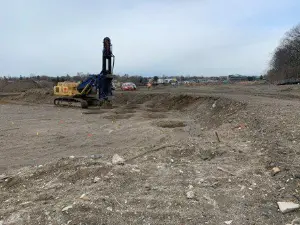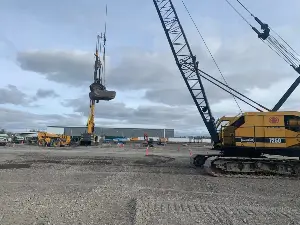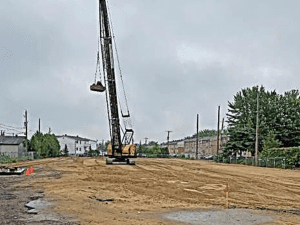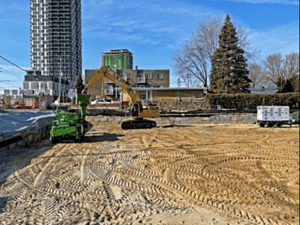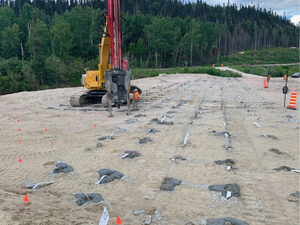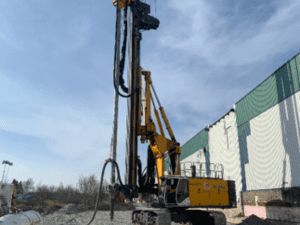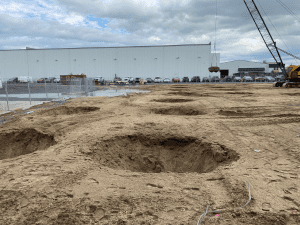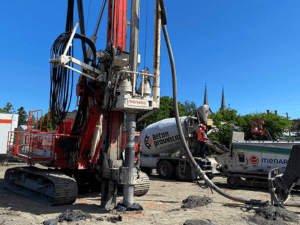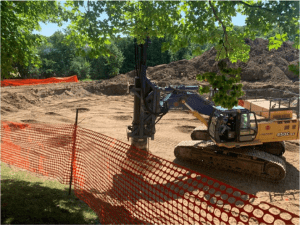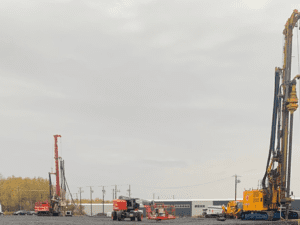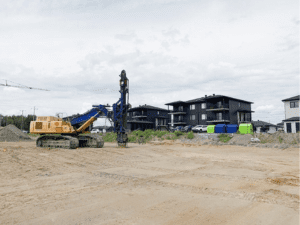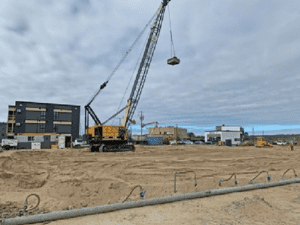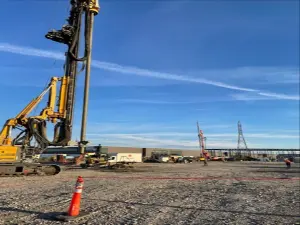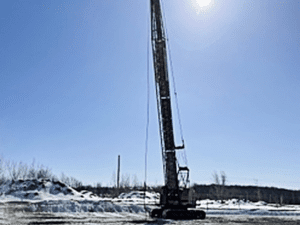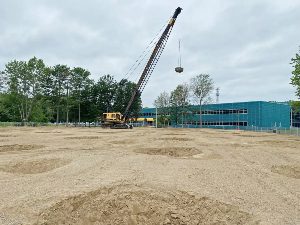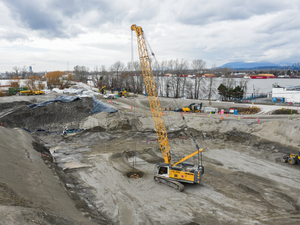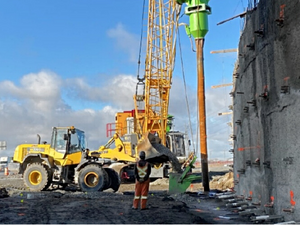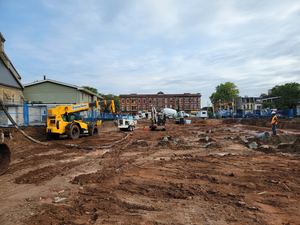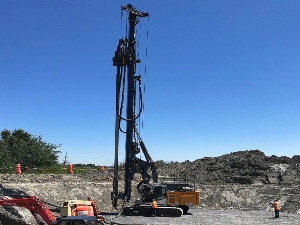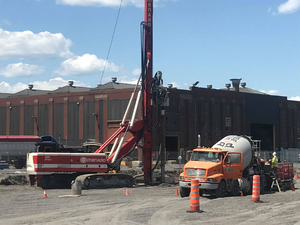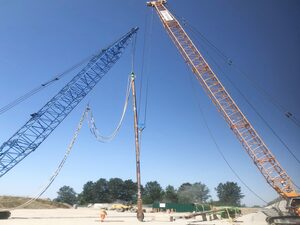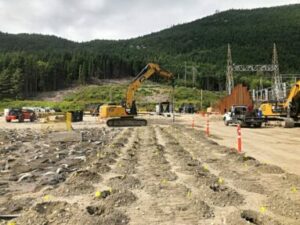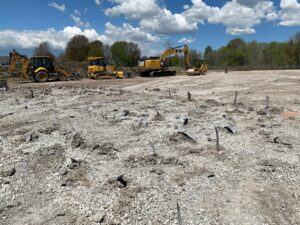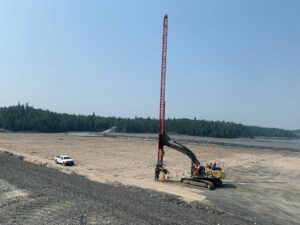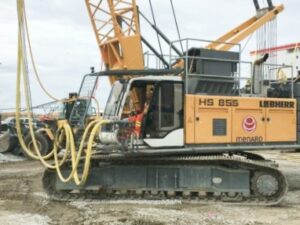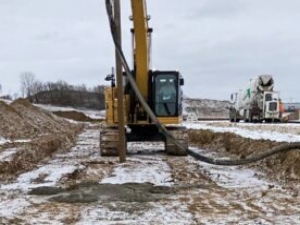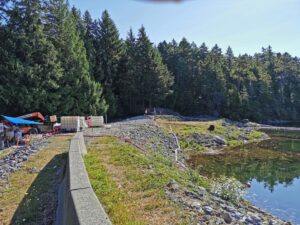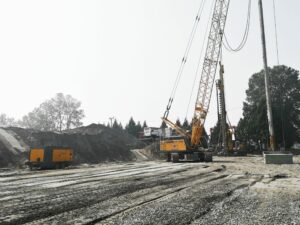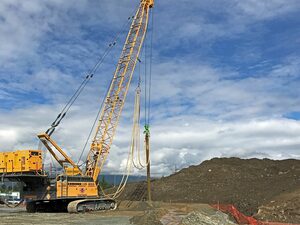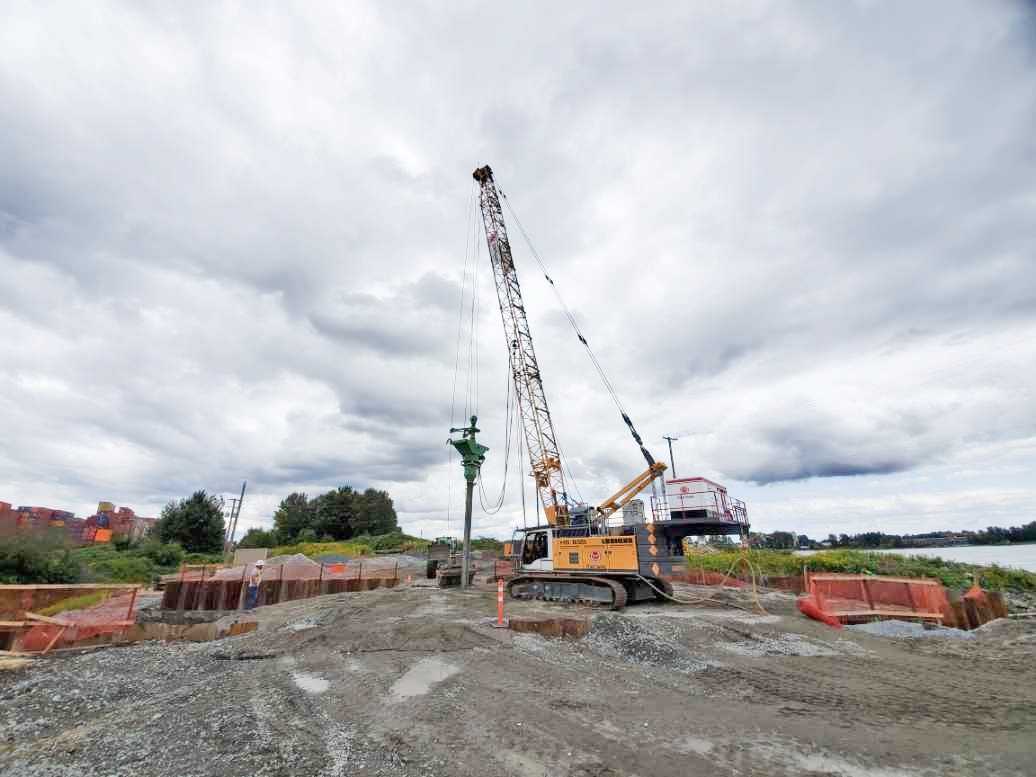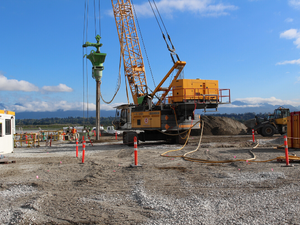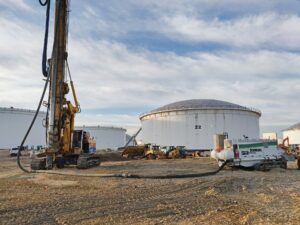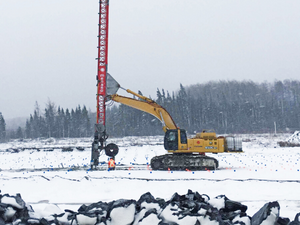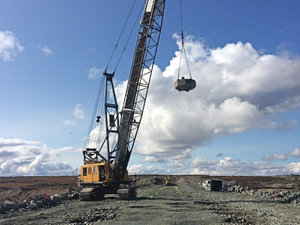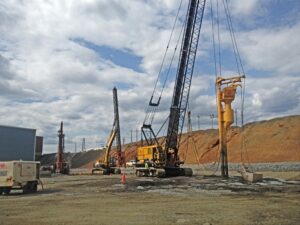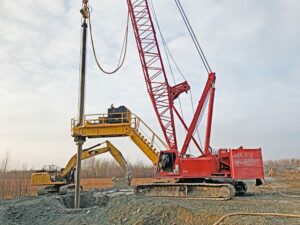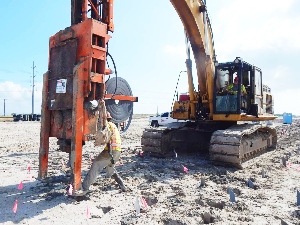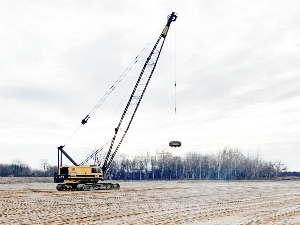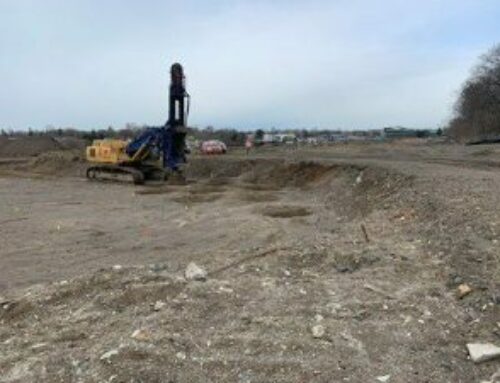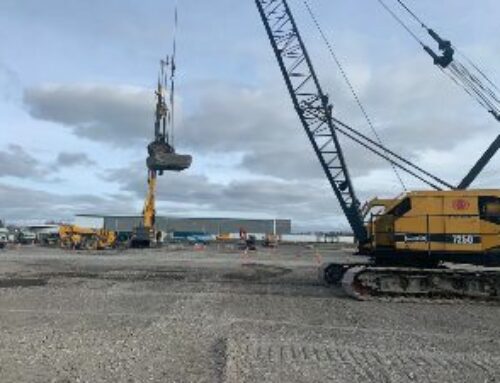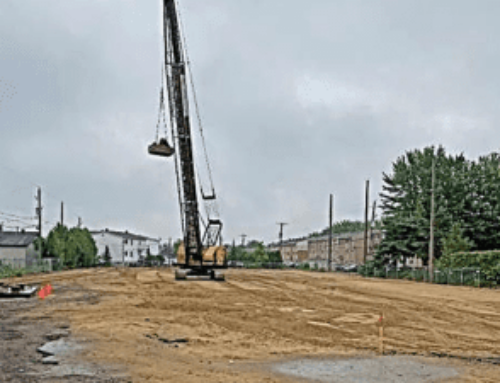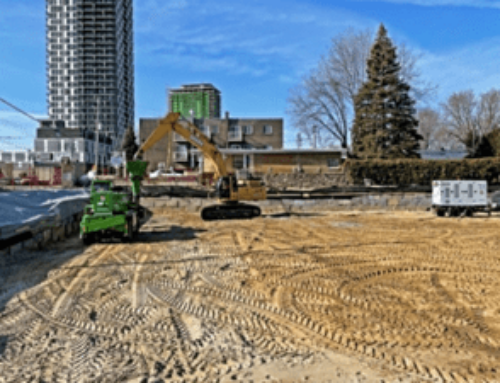Selected Technique:
Stone Columns with Vibroflot
Treatment Area:
Mob/demob.: 3 u
Primary SC (28.5m): 845 u
Secondary SC (13m): 429 u
The proposed development of the dike involved the installation of stone columns and timber piles to densify the 4200m2 (12m wide section running for 354m from west to east) strip adjacent to the existing FortisBC LNG Plant in Delta, BC. The property is bound by the Fraser River on the North, a commercial lot to its west, and the LNG plant to its South.
Ground Conditions
Subsurface conditions generally comprised of upper inter-bedded layers of sandy silt and clayey silt (until a 13m depth) with traces of wood and organics and a sandy layer extending to a depth of 28.5m. The sand layer is susceptible to liquefaction which risks the stability of the dike. A groundwater table was encountered at about 3.0m below the ground surface.
Menard Canada Solution
The solution ultimately consisted of a combination of Vibro Stone Columns at 28.5m depth using Wet Top Feed methodology and Timber Piles at 13m depth.
The deeper sand responded more readily and efficiently to Vibro treatment than the upper layer. Following completion of the trial area, it was decided to build additional SC at 13m depth at every second centroid to meet the specified CPT resistance.
The TP, subcontracted to a local contractor, FRPD, was ensuring the lateral stability of the dike in case of an earthquake. They were driven along the northern face of the ground improvement area at every centroid of the SC mesh.
The TP, subcontracted to a local contractor, FRPD, was ensuring the lateral stability of the dike in case of an earthquake. They were driven along the northern face of the ground improvement area at every centroid of the SC mesh.
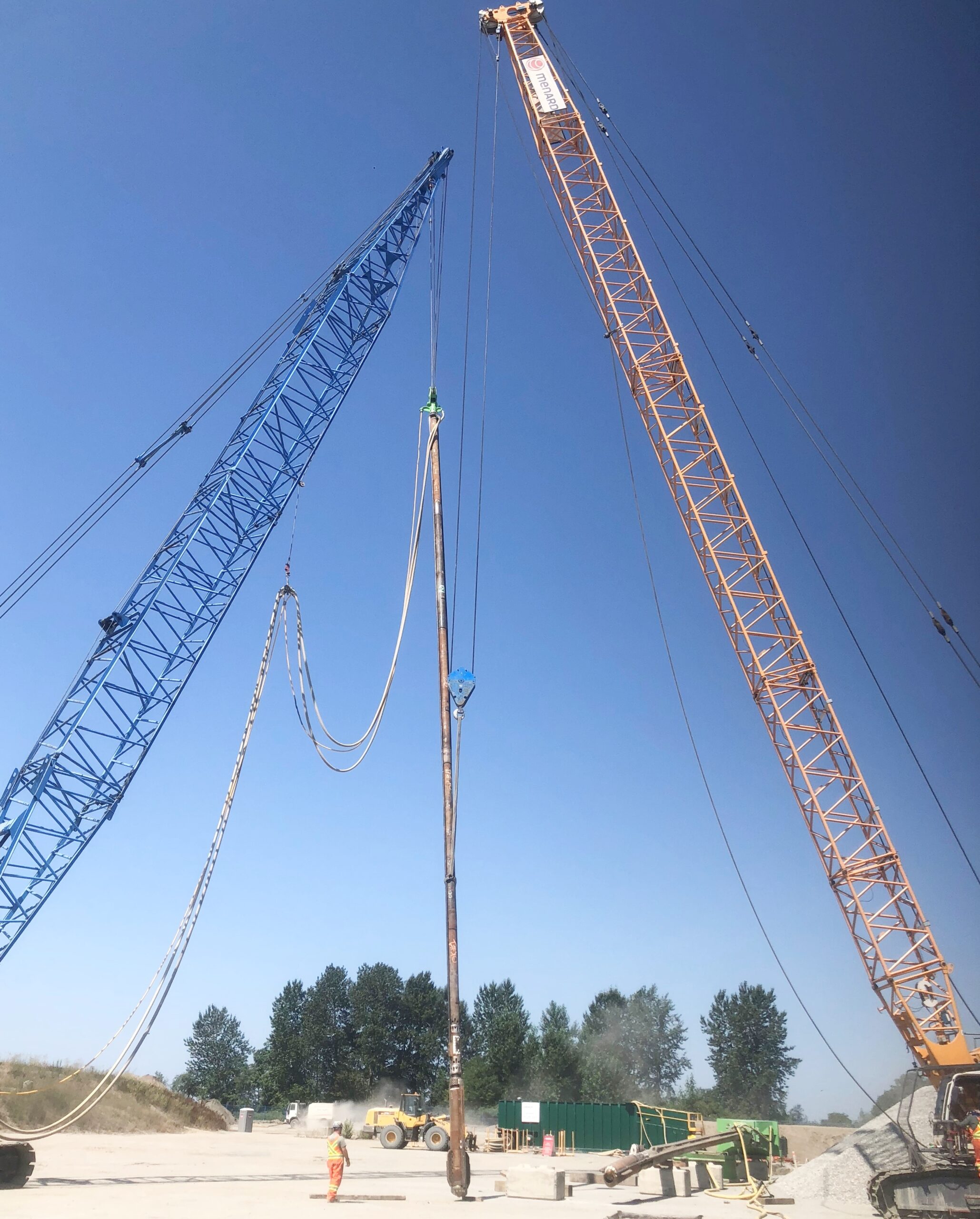
Stone Columns With Vibroflot Being Installed
Other projects
Birchley Park, Residential Housing – Toronto, Ontariomenardcanadainc2024-07-22T20:44:36+02:00
Birchley Park, Residential Housing – Toronto, Ontario
Metro Warehouse: Terrebonne, Québecmenardcanadainc2024-07-22T20:11:13+02:00
Metro Warehouse: Terrebonne, Québec
Multi-Housing: Saint-Charles-Borromée, Québecbenzion2023-11-16T16:23:02+01:00
Multi-Housing: Saint-Charles-Borromée, Québec
Residential Housing: Répentigny Québecbenzion2023-09-19T22:26:33+02:00
Residential Housing: Répentigny Québec
Rosefellow Industrial Building: Beauharnois, Québecbenzion2023-10-24T22:12:34+02:00
Rosefellow Industrial Building: Beauharnois, Québec
Manufacturing Facility: Val d’Or, Québecbenzion2023-11-16T18:07:54+01:00
Manufacturing Facility: Val d’Or, Québec
Fruit d’Or Processing Plant: Plessisville, Québecbenzion2023-11-16T17:31:01+01:00
Fruit d’Or Processing Plant: Plessisville, Québec
Residence: Sainte-Anne-des-Monts, Québecbenzion2023-11-15T21:38:08+01:00
Residence: Sainte-Anne-des-Monts, Québec
Communications Tower-Videotron: Rigaud, Québecbenzion2023-09-19T22:41:59+02:00
Communications Tower-Videotron: Rigaud, Québec
Warehouse CANAC: Saint-Nicolas, Québecbenzion2023-11-16T17:34:59+01:00
Warehouse CANAC: Saint-Nicolas, Québec
Commercial Buildings: Pont Rouge, Québecbenzion2023-09-19T20:12:30+02:00
Commercial Buildings: Pont Rouge, Québec
Residential Housing: Trois-Rivières, Québecbenzion2023-11-16T17:05:19+01:00
Residential Housing: Trois-Rivières, Québec
Acéricole Warehouse: Plessisville, Québecbenzion2024-07-22T19:58:00+02:00
Acéricole Warehouse: Plessisville, Québec
Government Buildings: Shawinigan, Québecbenzion2024-07-22T20:40:59+02:00
Government Buildings: Shawinigan, Québec
Manufacturing Plant, Innomalt: Bécancour, Québecbenzion2023-11-15T20:54:23+01:00
Manufacturing Plant, Innomalt: Bécancour, Québec
Oceanfront Park Phase A: Squamish, British Columbiamenardcanadainc2023-11-16T16:20:28+01:00
Oceanfront Park Phase A: Squamish, British Columbia
Waste Water Treatment Plant: Vancouver, British Columbiamenardcanadainc2023-11-23T10:58:52+01:00
Waste Water Treatment Plant: Vancouver, British Columbia
CP Rail, Coquitlam: British Columbiamenardcanadainc2023-05-02T22:47:42+02:00
CP Rail, Coquitlam: British Columbia
Highway 91-17: Delta, British Columbiamenardcanadainc2023-05-02T22:48:59+02:00
Highway 91-17: Delta, British Columbia
West Calgary Ring Road: Calgary, Albertamenardcanadainc2023-11-16T16:16:17+01:00
West Calgary Ring Road: Calgary, Alberta
Road 389 Upgrade: Baie Comeau, Québecmenardcanadainc2023-05-02T22:51:07+02:00
Road 389 Upgrade: Baie Comeau, Québec
Deltaport Facility: Delta British Colombiamenardcanadainc2023-11-16T17:10:59+01:00
Deltaport Facility: Delta British Colombia
Maison des Aînés: Alma, Québecmenardcanadainc2023-11-16T16:55:50+01:00
Maison des Aînés: Alma, Québec
School Building: Hamilton, Ontariomenardcanadainc2023-05-02T22:55:59+02:00
School Building: Hamilton, Ontario
Val-ÉO Wind Turbines: St-Gédéon, Québecbenzion2023-11-16T17:21:01+01:00
Val-ÉO Wind Turbines: St-Gédéon, Québec
Warehouse: Sorel-Tracy, Québecmenardcanadainc2023-11-16T18:12:02+01:00
Warehouse: Sorel-Tracy, Québec
Dike Upgrades: Delta, British Columbiabenzion2023-05-02T23:02:38+02:00
Dike Upgrades: Delta, British Columbia
U of T Student Residence: Toronto, Ontariomenardcanadainc2023-11-15T21:25:40+01:00
U of T Student Residence: Toronto, Ontario
Minette Substation: Kitimat, British Columbiabenzion2023-11-15T21:50:00+01:00
Minette Substation: Kitimat, British Columbia
Hydro One Operations: Dunnville, Ontariobenzion2023-05-02T23:07:05+02:00
Hydro One Operations: Dunnville, Ontario
Evolution Mining: Red Lake, Ontariobenzion2023-11-16T17:16:48+01:00
Evolution Mining: Red Lake, Ontario
Fraser Surrey Docks: Surrey, British Columbiamenardcanadainc2024-05-20T21:53:43+02:00
Fraser Surrey Docks: Surrey, British Columbia
Industrial Building: Brantford, Ontariobenzion2023-05-02T23:10:05+02:00
Industrial Building: Brantford, Ontario
Residential Development: Toronto, Ontariomenardcanadainc2023-05-02T22:45:02+02:00
Residential Development: Toronto, Ontario
Dam No. 5: Vancouver Island, British Columbiabenzion2023-05-02T22:43:18+02:00
Dam No. 5: Vancouver Island, British Columbia
Dike Upgrade: New Westminster, British Columbiabenzion2023-05-02T22:41:05+02:00
Dike Upgrade: New Westminster, British Columbia
Hotel Development: Thunder Bay, Ontariomenardcanadainc2023-05-02T22:38:38+02:00
Hotel Development: Thunder Bay, Ontario
Drainage Pump Station Upgrade: Vancouver, British Columbiabenzion2023-11-16T16:26:11+01:00
Drainage Pump Station Upgrade: Vancouver, British Columbia
Residential Subdivision: Whitby, Ontariomenardcanadainc2023-11-16T17:00:59+01:00
Residential Subdivision: Whitby, Ontario
Water Treatment Plant: Chilliwack, British Columbiabenzion2023-11-15T21:35:16+01:00
Water Treatment Plant: Chilliwack, British Columbia
Pumping Station: Richmond, British Columbiabenzion2023-11-15T21:36:30+01:00
Pumping Station: Richmond, British Columbia
YVR Airport: Richmond, British Colombiamenardcanadainc2023-11-15T21:28:47+01:00
YVR Airport: Richmond, British Colombia
Trans Mountain Expansion Project: Edmonton, Albertabenzion2023-11-15T21:42:22+01:00
Trans Mountain Expansion Project: Edmonton, Alberta
Canadian Malartic Mine: Malartic, Québecmenardcanadainc2023-11-16T16:43:20+01:00
Canadian Malartic Mine: Malartic, Québec
Whale Tail Dike: Amaruq, Nunavutmenardcanadainc2023-10-09T23:58:39+02:00
Whale Tail Dike: Amaruq, Nunavut
VALE Nickel Mines: Sudbury, Ontariomenardcanadainc2023-11-16T16:35:09+01:00
VALE Nickel Mines: Sudbury, Ontario
Wesdome Kiena Mine: Val d’or, Québecmenardcanadainc2023-11-23T11:25:17+01:00
Wesdome Kiena Mine: Val d’or, Québec
Hydro One Storage Facility: Dunnville, Ontariobenzion2023-05-02T22:14:22+02:00
Hydro One Storage Facility: Dunnville, Ontario
Industrial Building: Bécancour Québecbenzion2023-05-02T22:06:47+02:00

